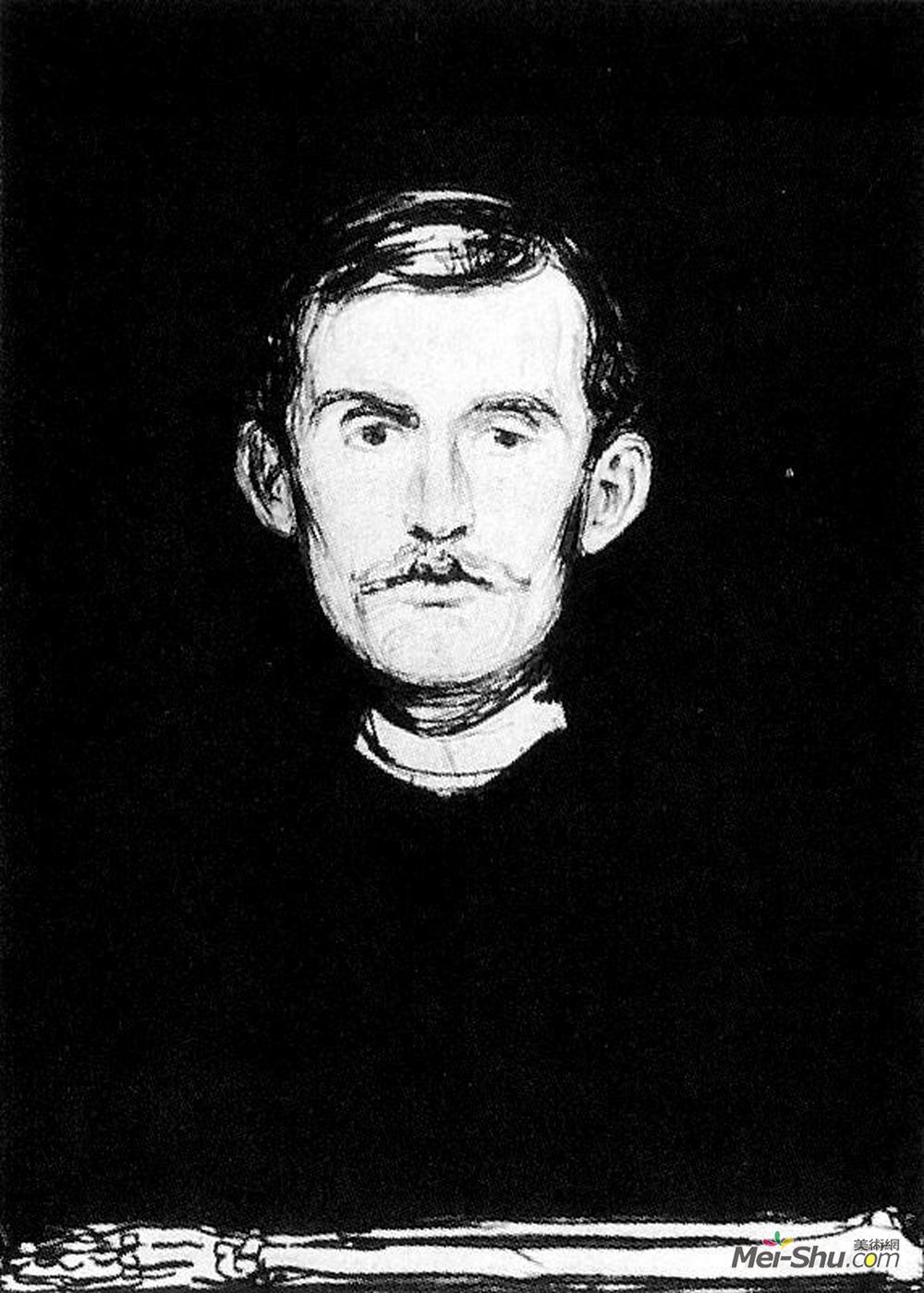
爱德华·蒙克(Edvard Munch)
艺术家: 爱德华·蒙克
生于: 1863;挪威十L的达尔斯布鲁克
卒于: 1944;挪威奥斯陆
国籍: 挪威
流派: 象征主义,表现主义
领域: 绘画
受影响: 保罗·高更,文森特·梵高,亨利·玛丽·雷蒙·德·图卢兹-劳特累克,乔治·修拉,卡斯帕尔·大卫·弗里德里希
影响: 埃贡·席勒,威斯利·康定斯基,恩斯特·路德维格·基尔希纳,马克斯·贝克曼,保罗·克利,亨利·马蒂斯,Expressionism,Surrealism
老师: Leon Bonnat
朋友: 弗朗茨·马克
机构: 慕尼黑(慕尼黑美术学院学院,慕尼黑,德国)
一个挪威出生的表现主义画家爱德华·蒙克在他的绘画中表现了一种动荡的生活。小时候,他经常在冬天生病,不上学。为了消磨时间,他每天都在画画。他还有一个麻烦的童年,因为他的母亲在他最小的妹妹出生后死于肺结核,他最喜欢的妹妹9年后死于同样的疾病。他的父亲也有点宗教狂热,他会读爱德华和他的妹妹的鬼故事和埃德加·艾伦·坡的故事。这些生动的可怕的故事,再加上他身体不好,年轻的芒奇被噩梦和偏执的死亡幻象所折磨,他后来会把这些幻象融入他的作品中。在他十几岁的时候,他从绘画和涉猎水彩画转到了油画,他只在技术学院呆了一年就离开了,去追逐他当画家的梦想。他早期的绘画作品招致了许多不利的批评,他的父亲斥责他的作品,但是仍然给他生活津贴。后来,由于对蒙克的画不满意,他毁掉了一幅裸体画,并拒绝再给他钱买艺术品。他大部分的生活都是虚无主义的、放荡不羁的生活方式,在这种生活方式中,酗酒和吵架是最受欢迎的消遣,这引起了他父亲的不满。在他父亲去世后,蒙奇家变得穷困潦倒,而蒙奇觉得他周围的人都已经去世了,他又被自杀的念头折磨着。他的个人悲剧和心理特质演变成一种象征性的艺术形式,表达了更多的内在情感和感受,而不是投射了外部现实的形象。他经常拒绝出售他的画,称之为他的孩子,因此会制作他们的复制品出售。到了19世纪90年代,他的批评性接待有所改善,参加展览的人数也增加了,尽管评论仍然很黯淡。1898,他开始和Tulla Larsen结婚,他想结婚。蒙克害怕婚姻和性关系一样,一年后逃离了图拉。在随后的和解努力中,有一场争吵,枪响了,打伤了芒奇的两个手指,毁掉了芒奇的婚姻机会。
1908年,芒奇与现实发生了剧烈的决裂,他看到了幻觉和遭受迫害的感觉,仿佛他已经到了危险的边缘。精神错乱的他开始治疗,包括控制饮食和电气化,从而稳定了他的个性。于是,他开始了一生中经济上和专业上更成功的阶段,在那里他得到了许多佣金,并能够为家人提供良好的生活。他在过去的二十年中,相对孤立地在他的许多庄园里画画。今天,他的遗产,曾经被谣言渲染成一个纳粹同情者,包括对他的作品的许多抢劫,他在拍卖会上的价格,现在他的脸部被以挪威货币为特色。
Artist :Edvard Munch
Additional Name :Edvard Munch
Born : Ådalsbruk in Løten, Norway
Died : Oslo, Norway
Nationality :Norwegian
Art Movement :Symbolism,Expressionism
Influenced by :paul-gauguin,vincent-van-gogh,henri-de-toulouse-lautrec,georges-seurat,caspar-david-friedrich
Influenced on :egon-schiele,wassily-kandinsky,ernst-ludwig-kirchner,max-beckmann,paul-klee,henri-matisse,artists-by-art-movement/expressionism,artists-by-art-movement/surrealism
Teachers :leon-bonnat
Friends and Co-workers :franz-marc
Art institution :Akademie der Bildenden Künste München (Munich Academy), Munich, Germany
A Norwegian born expressionist painter, Edvard Munch lived a tumultuous life, which was represented in his paintings. As a child, he was often ill in the winter, and kept out of school. To pass the time, he spent his days drawing. He also had a troubled childhood, as his mother died of tuberculosis after the birth of his youngest sister, and his favorite sister died of the same illness nine years later. His father was also a bit of a religious fanatic, who would read Edvard and his sisters ghost stories and the stories of Edgar Allen Poe. The vivid ghastly tales, combined with his poor health, the young Munch was plagued by nightmares and paranoid visions of death, which he would later incorporate into his artwork.
In his teens, he moved from drawing and dabbling with watercolors to painting with oils, and he only spent one year in technical college before he left to follow his dream of being a painter. His early paintings brought much unfavorable criticism, and his father rebuked him for his artworks, but continued to give him a living allowance. Later, unhappy with Munch’s paintings, he destroyed one of his nudes, and refused to grant him any more money for his art supplies.
Much live much of his life in a nihilistic, bohemian lifestyle, in which binge drinking and brawling were the favorite pastimes, to his father’s constant disapproval. After his father’s death, leaving the Munch family destitute, and Munch, feeling that everyone around him had died, was plagued by suicidal thoughts. His personal tragedies and psychological idiosyncrasies evolved into a symbolic art form that expressed more internal emotion and feeling than projected an image of outside reality. He often refused to sell his paintings, calling them his children, and so would create reproductions of them to sell.
His critical reception improved by the 1890’s, and the attendance to his exhibitions increased, although reviews remained bleak. In 1898, he began a relationship with Tulla Larsen, who wanted to get married. Munch, fearing marriage as much as sexual relationships, fled Tulla a year later. In a later reconciliation attempt, there was an argument in which a gun went off, injuring two of Munch’s fingers, and ruining Munch’s chance at marriage.
In 1908, Munch had an acute break with reality, seeing hallucinations and suffering feelings of persecution, as if he was on the brink of insanity. He began therapy, including a controlled diet and electrification, which stabilized his personality. Thus began his more financially and professionally successful phase in his life, where he received many commissions and was able to provide well for his family. He spent the last two decades of his life in relative isolation, painting at one of his many estates. Today his legacy, once smeared with rumors that he was a Nazi sympathizer, includes many robberies of his works, his prices at auction, and his face now being featured on the Norwegian currency.